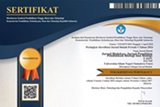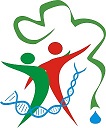Identification of quercetin compounds in cabbage (Brassica oleracea var. capitata L.) and mustard greens (Brassica juncea L.) from Malang Regency
Abstract
Keywords
Full Text:
PDFReferences
Agustin, T. (2020). Potensi metabolit aktif dalam sayuran cruciferous untuk menghambat pertumbuhan sel kanker. Jurnal Penelitian Perawat Profesional, 2(4), 459–472.
Aminah, A., Tomayahu, N., & Abidin, Z. (2017). Penetapan kadar flavonoid total ekstrak etanol kulit buah alpukat (Persea americana Mill.) dengan metode spektrofotometri UV-Vis. Jurnal Fitofarmaka Indonesia, 4(2), 226–230.
Andriani, S., & Anggraini, D. I. (2023). Uji aktivitas antikolesterol variasi ekstrak etanol sawi pakcoy (Brassica chinensis) secara In Vitro). Jurnal Farmasi Sains Dan Terapan, 10(1), 44–50. https://doi.org/10.33508/jfst.v10i1.4574
Bangun, P. P. A., Rahman, A. P., & H, S. (2021). Analisis kadar total flavonoid pada daun dan biji pepaya (Carica papaya L.) menggunakan metode spektrofotometer UV-Vis. Jurnal Ilmiah Farmasi Attamru, 22(02), 1–5.
Estikawati, I., & Lindawati, N. Y. (2019). Penetapan kadar flavonoid total buah oyong (Luffa acutangula (L.) Roxb.) dengan metode spektrofotometri UV-Vis. Jurnal Farmasi Sains Dan Praktis (JFSP), 5(2), 96–105.
Heldawati, H. (2016). Faktor-faktor yang mempengaruhi konsumsi sayur-sayuran di Kabupaten Hulu Sungai Utara Provinsi Kalimantan Selatan. Rawa Sains: Jurnal Sains STIPER Amuntai, 6(1), 12–17.
Ikalinus, R., Widyastuti, S. K., & Setiasih, N. L. E. (2015). Skrining fitokimia ekstrak etanol kulit batang kelor (Moringa oleifera). Indonesia Medicus Veterinus, 4(1), 71–79.
La, E. O. J., Sawiji, R. T., & Yuliani, N. M. R. (2021). Identifikasi kandungan metabolit sekunder dan uji aktivitas antioksidan ekstrak n-heksana kulit jeruk Bali (Citrus maxima Merr.). Jurnal Surya Medika (JSM), 6(2), 185–200.
Lindawati, N. Y., & Ma’ruf, S. H. (2020). Penetapan kadar total flavonoid ekstrak etanol kacang merah (Phaseolus vulgaris L.) dengan metode kompleks kolorimetri secara spektrofotometri visibel. Jurnal Ilmiah Manuntung, 6(1), 83–91.
M.Z, S., Putri, Y. I., & P, R. R. (2017). Ekstraksi kuersetin dari kulit terong belanda (Solanum betaceum Cav.) menggunakan pelarut etanol dengan metode maserasi dan sokletasi. Jurnal Teknik Kimia USU, 6(1), 36–42.
Melanie, M., Salenussa, M. W., & Lestario, L. N. (2023). Aktivitas antioksidan dan kandungan kuersetin ekstrak daun dan batang melati kosta. Jurnal Pangan Dan Agroindustri, 11(2), 100–106.
Miarti, A., & Legasari, L. (2022). Ketidakpastian pegukuran analisa kadar biuret, kadar nitrogen, dan kadar oil pada pupuk urea di laboratorium kontrol prodkasi PT pupuk sriwidjaja palembang. Jurnal Cakrawala Ilmiah, 2(3), 861–874.
Ningsih, I. S., Chatri, M., Advinda, L., & Violita, V. (2023). Snyawa aktif flavonoid yang terdapat pada tumbuhan. Jurnal Serambi Biologi, 8(2), 126–132.
Noer, S., Pratiwi, R. D., & Gresinta, E. (2018). Penetapan kadar senyawa fitokimia (Tanin, saponin, dan flavonoid sebagao kuersetin) pada ekstral daun inggu (Ruta angustifolia L.). EKSAKTA: Journa of Sciences and Data Anlysis, 18(1), 19–29. https://doi.org/10.20885/eksakta.vol18.iss1.art3
Nurdyansyah, F. (2017). Stres oksidatif dan status antioksidan pada latihan fisik. Jurnal Jendela Olahraga, 2(1), 105–109.
Prasetyaningsih, N., Hartanti, M. D., & Bella, I. (2023). Radikal bebas sebagai faktor risiko penyakit katarak terkait umur. Jurnal Penelitian Dan Karya Tulis Ilmiah Lembaga Penelitian Universitas Trisakti, 8(1), 1–7.
Pratama, A. N., & Busman, H. (2020). Potensi ntioksidan kedelai (Glycine Max L.) terhadap penangkapan radikal bebas. Jurnal Ilmiah Kesehatan Sandi Husada, 11(1), 497–504.
Pratiwi, A. ., Yusran, H., Isawati, I., & Artati, A. (2023). Analisis kadar antioksidan pada ekstrak daun binahong hijau Andrea cordifolia (Ten.) Steenis. BIOMA: Jurnal Biologi Makassar, 8(2), 66–74.
Rinninella, E., Fagotti, A., Cintoni, M., Raoul, P., Scaletta, G., Quagliozzi, L., Abele, G., Miggiano, D., Scambia, G., Gasbarrini, A., & Mele, M. C. (2019). Nutritional interventions to improve clinical outcomes in ovarian cancer: A systematic review of randomized controlled trials. Nutrients, 11(1404), 1–19.
Santosa, W. N., & Baharuddin, B. (2020). Penyakit jantung koroner dan antioksidan. KELUWIH: Jurnal Kesehatan Dan Kedokteran, 1(2), 95–100.
Seo, Y.-S., Park, J.-M., Kim, J.-H., & Lee, M.-Y. (2023). Cigarette smoke-induced reactive oxygen species formation: A concise review. Antioxidants, 12(1732), 1–24.
Sinaga, F. A. (2016). Stress oksidatif dan status antioksidan pada aktivitas fisik maksimal. Jurnal Generasi Kampus, 9(2), 176–189.
Suwartini, L., Yanti, N., & Efrinalia, W. (2021). Optimasi kondisi pengujian senyawa flavonoid total di dalam ekstrak tanaman sebagai pengayaan bahan ajar praktikum makromolekul dan hasil alam di laboratorium kimi organik. Jurnal Penelitian Sains, 23(1), 28–35.
Widhaswara, C. Y., & Sardjito, S. (2017). Penentuan kawasan agropolitan berdasarkan komoditas unggulan tanaman hortikultura di Kabupaten Malang. Jurnal Teknik ITS, 6(2), 2337–3520.
Zhang, N.-Q., Ho, S. C., Mo, X.-F., Lin, F.-Y., H., W.-Q., L., H., Huang, J., & Zhang, C.-X. (2018). Glucosinolate and isothiocyanate intakes are inversely associated with breast cancer risk: a case-control study in China. British Journal of Nutritions, 119(8), 957–964.
Zharani, M. Al, Mubarak, M., Rudyani, H. A., Doasiss, A. A. Al, Elwahab, M. M. A., & Eissa, M. S. Al. (2023). Quercetin as a dietary supplementary flavonoid alleviates the oxidative stress induced by lead toxicity in male wistar rats. Nutrients, 15(1888), 1–15.
Zuraida, Z., Sulistiyani, S., Sajuthi, D., & Suparto, I. H. (2017). Fenol, flavonoid, dan aktivitas antioksidan pada ekstrak kulit batang pulai (Alstonia scholaris R.Br). Jurnal Penelitian Hasil Hutan, 35(3), 211–219. https://doi.org/10.20886/jphh.2017.35.3.211-219
DOI: http://dx.doi.org/10.30821/biolokus.v8i1.3637
Refbacks
- There are currently no refbacks.
Copyright (c) 2025 Jurnal Biolokus: Jurnal Penelitian Pendidikan Biologi dan Biologi
indexed by :












